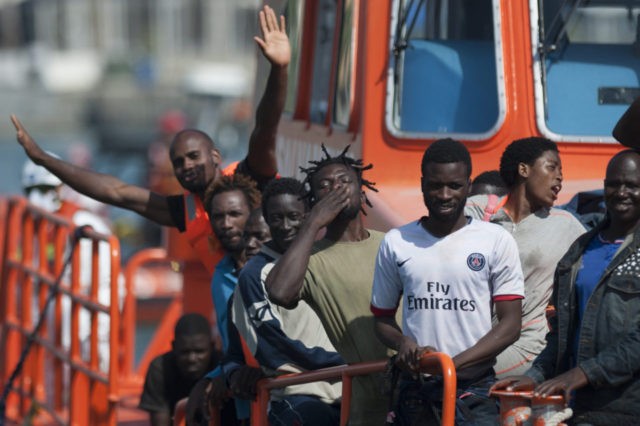In a remarkably blunt analysis of the massive migration from North Africa to Italy in 2016, the European Frontex agency has denounced human traffickers’ exploitation of NGOs to efficiently transport African migrants from Libya to Italy.
The NGOs, the report suggests, whether knowingly or not, have become accomplices to people smugglers by providing a reliable shuttle service for migrants from Africa to Europe, lowering smugglers’ costs and improving their “business model.”
The assistance by NGOs has virtually eliminated the need for traffickers to procure seaworthy vessels capable of making the dangerous voyage across the southern Mediterranean, the report notes, since traffickers need only transport their passengers a few miles off the Libyan coast where they will be picked up by “rescue” vessels. It also allows traffickers to operate without fear of arrest by law enforcement.
Frontex, the European agency in charge of control of the EU’s borders, has identified a major shift in maritime rescue operations from military vessels to NGOs, a shift intentionally orchestrated by traffickers.
Midway through its 64-page report, Frontex notes that in throughout 2015, and the first months of 2016, NGO vessels were involved in less than 5% of rescue operations, whereas from June until October 2016, “the pattern was reversed” and NGO rescue operations “rose significantly to more than 40% of all incidents.”
This happened because of a change in strategy by the people smugglers, the report notes.
During the first period, “smuggling groups instructed migrants to make satellite phone calls to the Maritime Rescue Coordination Centre (MRCC) in Rome to initiate targeted rescues on the high seas,” the report states. More than 50 percent of all search and rescue (SAR) operations were initiated in this way, and the missions were mainly undertaken by Italian law-enforcement.
As of 2016, however, satellite phone calls to MRCC Rome decreased sharply to 10 percent and the military began playing a significantly diminished role in rescue operations.
Since June 2016, the report continues, a significant number of boats have been intercepted by NGO vessels “without any prior distress call and without official information as to the rescue location.”
These rescues did not occur somewhere out in the Mediterranean, but extremely near the Libyan coast, and sometimes even in Libyan territorial waters. “NGO presence and activities close to, and occasionally within, the 12-mile Libyan territorial waters nearly doubled compared with the previous year,” Frontex states, and as a result, “the overall number of incidents increased dramatically.”
According to statistical data, criminal networks, particularly Libyan-based smugglers, have relied heavily on SAR missions, as well as humanitarian assistance efforts, “turning it into a distinct tactical advantage,” the report states, adding that “the scope of the problem is alarming.”
Frontex delicately adds that “all parties involved in SAR operations in the Central Mediterranean unintentionally help criminals achieve their objectives at minimum cost, strengthen their business model by increasing the chances of success.”
Moreover, the report continues, “Migrants and refugees – encouraged by the stories of those who had successfully made it in the past – attempt the dangerous crossing since they are aware of and rely on humanitarian assistance to reach the EU.”
The Frontex report found that the ready availability of effective SAR operations has served to stimulate demand for smugglers services, by making migration to Europe more accessible, resulting in what Frontex describes as a “pull factor.”
SAR missions near the Libyan coast have had “unintended consequences,” the report states. “Namely, they influence smugglers’ planning and act as a pull factor that compounds the difficulties inherent in border control and saving lives at sea.”
“Dangerous crossings on unseaworthy and overloaded vessels were organised with the main purpose of being detected by EUNAVFOR Med/Frontex and NGO vessels,” the reports adds.
All in all, in 2016, the Central Mediterranean “saw the highest number of migrant arrivals ever recorded from sub-Sahara, West Africa and the Horn of Africa,” totally 181,459 migrants, or an increase of 18 percent over the previous year.
This trend shows that the Central Mediterranean “has become the main route for African migrants to the EU and it is very likely to remain so for the foreseeable future,” the report states.
In its report, Frontex proposes a remedy to the uncontrolled migrant flows presently in effect by pointing to a strategy that has already yielded promising results elsewhere.
The dangerous Western African route, the report notes, “was closed thanks to an effective combination of border surveillance, return operations, and joint law-enforcement work with countries of origin/departure.”
“This model represents one of the best ways to prevent a future migratory crisis in the Central Mediterranean,” it concludes.
Follow Thomas D. Williams on Twitter Follow @tdwilliamsrome

COMMENTS
Please let us know if you're having issues with commenting.